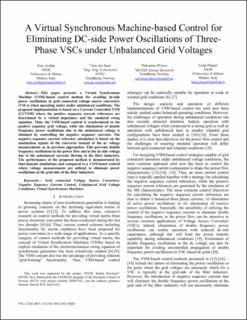A Virtual Synchronous Machine-based Control for Eliminating DC-side Power Oscillations of Three-Phase VSCs under Unbalanced Grid Voltages
Chapter
Accepted version
Permanent lenke
https://hdl.handle.net/11250/2990683Utgivelsesdato
2021Metadata
Vis full innførselSamlinger
Originalversjon
10.1109/CPE-POWERENG50821.2021.9501184Sammendrag
This paper presents a Virtual Synchronous Machine (VSM)-based control method for avoiding dc-side power oscillations in grid connected voltage source converters (VSCs) when operating under under unbalanced conditions. The proposed implementation is based on a Current Controlled VSM (CCVSM) where the positive sequence current references are determined by a virtual impedance and the emulated swing equation. Thus, the VSM-based control is synchronized to the positive sequence grid voltage, while the elimination of double frequency power oscillations due to the unbalanced voltage is obtained by controlling the negative sequence currents. The negative sequence current reference calculation is based on the modulation signals of the converter instead of the ac voltage measurements as in previous approaches. This prevents double frequency oscillations in the power flow and in the dc side voltage due to the unbalanced currents flowing in the filter inductors. The performance of the proposed method is demonstrated by time-domain simulations and compared to a VSM-based control where voltage measurements are utilized to eliminate power oscillations at the grid-side of the filter inductors.
